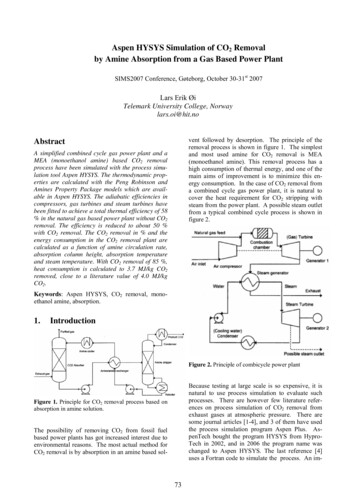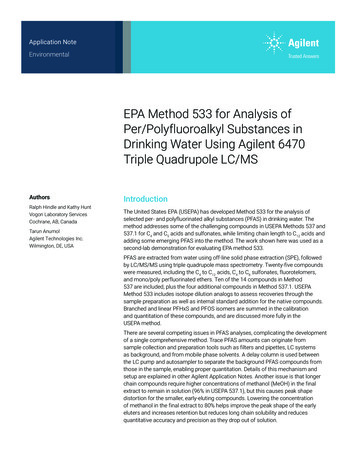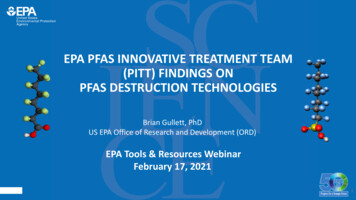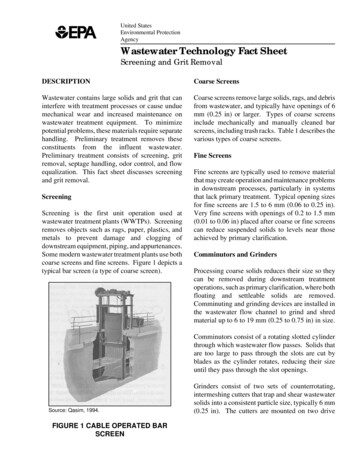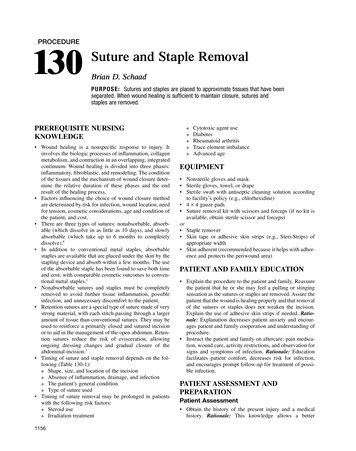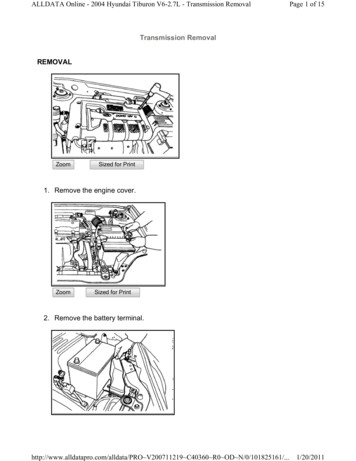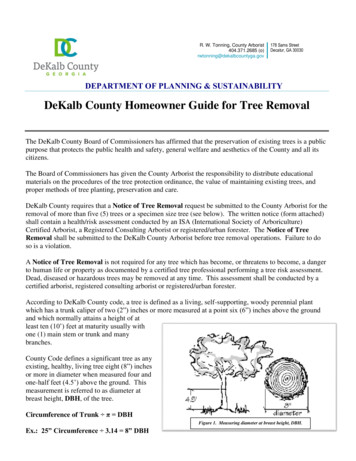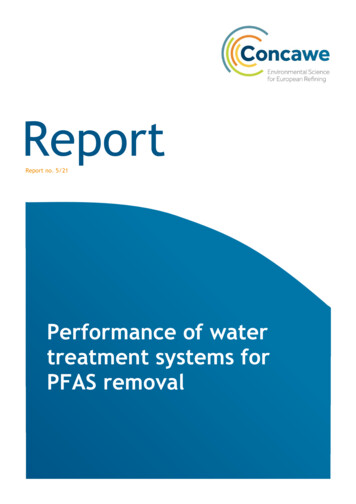
Transcription
ReportReport no. 5/21"Performance of watertreatment systems forPFAS removal
report no. 5/21Performance of watertreatment systems forPFAS removalThis report was prepared by:Kees Roest, Thomas L. ter Laak, Hans Huiting, Wolter Siegers, Nienke Meekel (KWR),Coen de Jong, Martijn de Jong, Martijn van Houten, Tessa Pancras, Wim Plaisier(Expertisecentrum PFAS), Joost Dalmijn (UvA)Under the supervision of:E. Vaiopoulou (Concawe Science Executive)M. Hjort (Concawe Science Associate)At the request of:Concawe Special Task on Soil and Groundwater (WQ/STF-33)Thanks for their contribution to:Members of WQ/STF-33: M. Bonte, P. Eyraud, R. Gill, T. Greaves, T. Grosjean,A. Medve, T. Nolte, J. Smith, C. VautierConcawe Legal Advisor: G. CrichlowMembers of Legal Issue Group (FuelsEurope)Reproduction permitted with due acknowledgement ConcaweBrusselsJune 2021I
report no. 5/21ABSTRACTPer- and polyfluoroalkyl substances (PFAS) are a group of widely used man-madeorganic chemical substances. They contain alkyl groups on which all or many of thehydrogen atoms have been replaced with fluorine. As such, they contain at leastone perfluoroalkyl moiety, –(CF2)n–. PFAS have been used because of their particularphysicochemical properties: most are stable at high temperatures, recalcitrant tochemical oxidation and biological degradation (i.e., persistent), and act as asurfactant. Although beyond the scope of this report, as reported by the AustralianMinistry of Defense 6, among others these properties mean there are a wide varietyof PFAS-containing materials (e.g stain- resistant fabrics, nonstick cookware,polishes, personal care products, and fire-fighting foams), or materials where PFASis used in the process (e.g. Mist suppression in metal plating or photography). Manysuch substances may also be bio-accumulative and toxic.In this study several treatment technologies for PFAS removal were tested in thelaboratory on both groundwater containing PFAS, and firefighting wastewaterobtained from a firefighting training site where firefighting foam was applied. orbents,coagulation/flocculation, nanofiltration, foam- and ozo fractionation technologies.In all cases the PFAS removal effectiveness was evaluated.This report provides: Criteria andtechnologies. Results of these performance tests of water treatment technologies for PFASremoval. Practicalities such as availability of the technology and experimental feasibilitywhich are included in the evaluation. Recommendations for selection of treatment technologies for PFAS removal inpractice for impacted groundwater and firefighting reatmentExperiments showed that all tested sorbents were able to remove PFAS fromfirefighting wastewater but the required sorbent dosages were in the g/L range. Itis therefore concluded that groundwater containing PFAS can be treated with oneof the tested sorbents directly, while for firefighting wastewater, which typicallyhas higher PFAS concentrations as well as other contaminants, a treatment trainapproach is likely to be more efficient. An initial treatment, such as flocculation,nanofiltration or foam- / ozo fractionation that removes bulk PFAS load includingco-contaminants followed by a polishing treatment (e.g. sorbents) that furtherreduces PFAS concentrations to acceptable levels is advised, unless a relative smallfixed volume of firefighting wastewater needs to be treated.This study provides a basis for readers of this publication to select, study and applythe best available technologies to mitigate risks associated with PFAScontamination.II
report no. 5/21KEYWORDSPFAS (per- and polyfluoroalkyl substances), PFCA (per- and polyfluoroalkylcarboxylic acids), PFSA (per- and polyfluoroalkyl sulfonic acids), long-chain, shortchain, precursors, treatment technologies, PFAS impacted groundwater,firefighting wastewater, comparative evaluation, batch testing, pilot testingINTERNETThis report is available as an Adobe pdf file on the Concawe website(www.concawe.org).NOTEConsiderable efforts have been made to assure the accuracy and reliability of the informationcontained in this publication. However, neither Concawe nor any company participating inConcawe can accept liability for any loss, damage or injury whatsoever resulting from the useof this information.This report does not necessarily represent the views of any company participating in Concawe.III
report no. 2.AIM1122.PART 1: TECHNOLOGY SELECTION2.1.OVERVIEW OF TECHNOLOGY CONCEPTS2.2.SELECTING TECHNOLOGIES FOR TREATING PFAS INGROUNDWATER AND FIREFIGHTING WASTEWATER2.2.1.Preliminary criteria2.2.2.Selection of technologies for experimental testing2.2.2.1.Sorption technologies2.2.2.2.Physical separation technologies2.2.2.3.Reactive degradation2.2.2.4.Selection of technologies333.4.IV4444556PART 2: TECHNOLOGY TESTING3.1.PFAS IMPACTED WATER3.2.EXPERIMENTAL SET UP OF REMOVAL TESTS3.3.RESULTS AND DISCUSSION3.3.1.Results PFAS composition3.3.2.Results TOP assay3.3.3.Discussion TOP assay results3.3.4.Other constituents in PFAS impacted waters3.3.5.Results batch sorption and flocculation tests - firefightingwastewater3.3.6.Results batch sorption and flocculation tests - impactedgroundwater3.3.7.Results batch sorption and flocculation tests - Impactedgroundwater spiked with benzene3.3.8.Discussion batch sorption and flocculant tests3.3.9.Results foam fractionation with ozone and air3.3.10.Discussion foam fractionation with ozone and air3.3.11.Results nanofiltration tests3.3.12.Discussion nanofiltration tests3.3.13.Results small-scale column tests3.3.14.Discussion of small–scale column tests7788891212PART 3: TECHNOLOGY APPLICATION4.1.ACTIVATED CARBON4.1.1.Introduction4.1.2.Performance4.1.3.Key Design criteria4.1.4.Operational aspects4.1.5.Costs4.2.REMBIND 4.2.1.Introduction4.2.2.Performance4.2.3.Key Design criteria4.2.4.Operational aspects4.2.5.Costs4.3.DEXSORB 141720202224252629
report no. 8.5.5.PerformanceKey Design criteriaOperational aspectsCostsPOLYQA-OSORB IntroductionPerformanceKey Design criteriaOperational aspectsCostsFLUORO-SORB IntroductionPerformanceKey Design criteriaPre-treatmentOperational aspectsCostsPERFLUORADIntroductionPerformanceKey Design criteriaOperational ey Design criteriaOperational aspectsCostsFOAM- AND OZO FRACTIONATIONIntroductionPerformanceKey Design criteriaOperational aspectsCostsDISCUSSION AND ulation5.1.3.Separation by foam or membrane filtration5.1.4.PFAS removal in relation to matrix composition andphysicochemical characteristics of the PFAS5.1.5.Evaluating and combining techniques towards practicalapplication5.1.6.Lookup 65757585859606060616163636565656666676768V
report no. APPENDIX 1:SAMPLE PREPARATION AND CHEMICAL ANALYSIS OF PFAS75APPENDIX 2:DETAILS OF TREATMENT CONCEPTS83APPENDIX 3:DETAILS OF EXPERIMENTAL SET UP BATCH SORPTIONEXPERIMENTS WITH ADSSORBENTS AND FLOCCULANT85APPENDIX 4:DETAILS OF EXPERIMENTAL SET UP FOAM FRACTIONATION WITHFIREFIGHTING WASTEWATER87APPENDIX 5:DETAILS OF EXPERIMENTAL SET UP MEMBRANE SEPARATIONWITH FIREFIGHTING WASTEWATER93APPENDIX 6:DETAILS ON SET UP SMALL SCALE COLUMN EXPERIMENTS95APPENDIX 7:ANALYTICAL METHODS AND RESULTS OF OTHER CONSTITUENTS98APPENDIX 8:SORPTION ISOTHERMS OF BATCH SORPTION TESTS WITHGROUNDWATER101APPENDIX 9:SORBENT LOADING RATES102APPENDIX 10:STRUCTURE OF ACTIVATED CARBON AND PFAS SORPTION103APPENDIX 11:OVERVIEW OF TREATMENT TECHNOLOGIES FOR GROUNDWATERAND FIREFIGHTING WASTEWATER 1104VI
report no. 5/21SUMMARYPer- and polyfluoroalkyl substances (PFAS) are a group of widely used man-madeorganic chemicals. They contain one alkyl groups on which hydrogen atoms havebeen replaced with fluorine. As such, they contain at least one perfluoroalkylmoiety, –(CF2)n–. PFAS have been used because of their particular physicochemicalproperties: most are stable at high temperatures, recalcitrant to chemical oxidationand biological degradation (i.e. persistent), and act as a surfactant. Many of suchsubstances may also be bioaccumulative and toxic. PFAS were first synthesised inthe 1940’s and commercialised in the 1950’s in stain-resistant products. PFAScontaining fire-fighting foams were developed for military applications in the mid1960’s but became available for commercial fire-fighting uses in the late 1960’s /early 1970’s. The oil and gas industry is unlikely to have used PFAS-containing foamsprior to circa 1970. In 2018, the OECD defined over 4,000 different CAS numbersrepresenting chemicals that can be considered PFAS and this number is growingeach year. Release of PFAS-foams to the environment may have occurred during: Firefighting incidents Firefighting practice and training Vapour suppression during hot work Firefighting foam storage, dispensing and handling Firefighting system testingUses of foam for firefighting lead to contamination of groundwater. They werecommonly used at many industrial sites including petrochemical plants (and othersites with bulk fuel storage, such as military and civil aviation facilities) and atfirefighting training sites co-located on petrochemical industry sites, or at thirdparty training facilities operated commercially or by public fire brigades. Thisreport seeks to help Concawe members, and others, identify suitable technologiesto treat PFAS from firefighting foams in groundwater, and mitigate new emissionsby on-site treatment of firefighting wastewater residues. Within this studytreatment technologies for both types of impacted waters have been studied. Inaddition the tested groundwater was spiked with benzene for selected experimentsto study the effects of petrochemical co-contamination on the treatmentperformance.This study contains two parts. First, a series of promising treatment technologies toseparate PFAS from aqueous phases were tested in a laboratory setting usinggroundwater and wastewater obtained from a firefighting training site. Second,these technologies were also evaluated in a desk based assessment considering theirpractical application in the field, costs and potential production of waste. Inaddition information was gathered on costs, generation of waste, reuse possibilitiesand the physical footprint of such a technique, which can be a constraint wheninsufficient space is available.The selected technologies were: treatment by a variety of sorbents in batch (bottle)and continuous (column) tests, coagulation/flocculation in batch tests andnanofiltration, foam- and ozo-fractionation in a continuous tests. In batch tests alltested sorbents are capable of removing over 85% total PFAS from both PFASimpacted groundwater (with or without added benzene) as well as firefightingwastewater (FFWW). However, as concentrations of PFAS in the firefightingwastewater were roughly three orders of magnitude higher than in the groundwater,sorbent dosages in the g/L range were required to obtain PFAS removal. The testedVII
report no. 5/21coagulant reduced PFAS concentrations at lower dosages as compared othersorbents for both firefighting wastewater and PFAS-impacted groundwater.However, PFAS levels did not fully drop below limits of detection at the highestdosages.The tested foam fractionation with and without ozone separated 60 to 90% of thePFAS from the bulk water by concentrating it in a foam matrix. These removal rateswere considered insufficient as a stand-alone treatment for the tested waters asPFAS concentrations were at µg/L level and mg/L level after treatment forgroundwater and firefighting wastewater, respectively. Therefore additionaltreatment / polishing is advised. Similar results were observed for a nanofiltrationmembrane that was solely tested with the firefighting wastewater. Although theinitial removal exceeded 95%, fouling occurred after several hours to a day ofoperation. Thus, the firefighting wastewater might require pre-treatment toprolong membrane service life. All in all this leads to the conclusion that all testedsorbents were able to remove PFAS from firefighting wastewater but the requiredsorbent dosages were very high. Therefore, a treatment train approach where aninitial treatment, such as flocculation, nanofiltration or foam- / ozo- fractionationthat removes bulk PFAS load including co-contaminants, and a second polishingtreatment (e.g. sorbents) that further reduces PFAS concentrations to acceptablelevels is likely to be more efficient for large volumes of firefighting wastewater.Results were collected and summarized in the lookup table below. This tableprovides a basis for readers of this publication to select, study and apply the bestavailable technologies to mitigate risks associated with PFAS present in groundwaterand firewater.VIII
report no. 5/21Table I:Lookup table on advantages and disadvantages of treatment technologies. Colours ranging from red (-- very poor) via orange (-poor) and yellow(fair) to green ( , good and , very good); n.a. (grey) is not assessed, or the data is ain treatmentOperational aspectsCostsTurbidityFn/MnTOCContact timeHydraulicloading rate/filtrationvelocityFixed bed filtration,lag/lead configuration---20-30 min10- 15 m/h minimal00 0-- 2 options:1: discontinuous batchwith sedimentation2: mixed media filterwith sand---5-10 min, 80%sorptionunknown unknown, expected minimal00 0unknownShortChainPFASLongchainPFAS Treatment strategyContaminantloading rateBed lifetimeEffects of temperature andpressureEnergyuseMaintenanceand onDESOTEC GranularActivated Carbon(GAC)Hydrophobic, (pipi) electrostaticand ionicinteractions Rembind (RB)Hydrophobic- ,electrostaticand (an)ionicinteractions Cyclopure DEXSORB (CP)Hydrophobicand electrostaticinteractions- Fixed bed filtration,lag/lead configuration,with on-siteregeneration possible-0 3-10 minunknown,expectedaround 10m/h 0unknown, expected minimal00 withoutregeneration- withregeneration-- 0PolyQA-Osorb (PQ)Hydrophobicand ionicinteractions0 (a)not clear yet, possiblefixed bed filtrationwith regeneration-----1-5 minunknown,expectedaround 10m/h0n.a.unknown, expected low. Possiblepressure effects on swelling ofmaterial00 withoutregeneration-1 withregeneration-- 0FLUORO-SORB Des (FS)Hydrophobic andelectrostaticinteractions Flow-through filter orbatch treatment withsedimentation orfloatation--02-10 minup to 15m/h unknown, expected minimal00 0Hydrophobicand electrostaticinteractions (b) (b)mixing tank,sedimentation,filtration 0 up to 60 minfor filtrationup to 15 m/h n.a.unknown, expected betterperformance with increasingtemperature--------Nanofiltration (c)Size exclusion- Filter units0 (d)00 (d)n/a (short)n/an.a.n.a.Increasing temperature haspositive effects on operationalaspects, increased pre-pressurereduces pump energy-----------Foam fractionationWITH OZONESurface activecharacteristics ofPFAS- multiple contacttank(s) in series withcompressed ozonebubbles 20-40 minn/an.a.n.a.Unknown, but highertemperatures negatively affectgas transfer and saturation, thismight have adverse effects-----0 -Foam fractionationWITHOUT OZONESurface activecharacteristics ofPFAS-0Discontinuous batchcontact tank withcompressed airbubbles 20-40 minn/an.a.n.a.Unknown, but highertemperatures negatively affectgas transfer and saturation, thismight have adverse effects00 2-3FlocculationPerfluorAd (PFAD)Other separationtechnologiesa) determination of sorption coefficients was complicated for GWb) based on removal performance for firefighting wastewaterc) initial performance before foulingd) suspended solids and TOC were higher than operational range stated by vendorI
report no. 5/211.INTRODUCTION1.1.PFASPer- and polyfluoroalkyl substances (PFAS) are a group of widely used man-madeorganic chemicals. They contain one alkyl groups on which hydrogen atoms havebeen replaced with fluorine. As such, they contain at least one perfluoroalkylmoiety, –(CF2)n–.4 PFAS have been used because of their particular physicochemicalproperties: some are stable at high temperatures, recalcitrant to chemicaloxidation and biological degradation, and act as a surfactant. Many also have oneor more of the following properties: recalcitrant to degradation (i.e., persistent),subject to bioaccumulation, and toxic. These polyfluorinated compounds maytransform into fully saturated perfluorinated compounds in the environment:polyfluorinated compounds can act as precursors to the perfluorinated molecules.In 2018, the OECD defined over 4,000 different CAS numbers representing chemicalsthat can be considered PFAS.5Figure 1:PFAS applications / sources (kindly provided by the AustralianMinistry of Defense)6These substances act as surfactants and can reduce surface tension betweenaqueous and hydrophobic phases, which makes them water and oil repellent. PFASare widely used, as illustrated in Figure 1 and described further by Gluge, et al. 7.Their properties benefit applications but are a potential risk for the environment.These properties potentially lead to persistence, bio-accumulation, and toxicity.Furthermore, the properties also complicate removal during water treatment suchas remediation of impacted groundwater and treatment of residues from usedfirefighting foams. In firefighting (including within the petrochemical industry),1
report no. 5/21PFAS-containing fire-fighting foams have been used to suppress flammable liquidfires or for firefighting training and spill control since about 1970. The compositionof these firefighting foams changed over the past decades as a result of thedevelopment of new fluor-containing additives and regulations.The potential persistence and toxicity of PFAS are reflected in water quality criteriaand other regulatory thresholds down to the ng/L range for some PFAS 8-9. Thischallenges PFAS-producers, PFAS-containing product manufacturers, and users ofPFAS-containing products across society and industry, to reduce emissions to theenvironment and study the impact of this diverse group of compounds.As a result of firefighting activities in a training setting or real situation, PFAS canbe emitted. Firefighting initially results in large volumes of firefighting wastewater(FFWW), which can contaminate surface waters and groundwater (GW) whentreatment and containment of the wastewater is not performed appropriately.Conventional treatment systems such as rapid sand filtration are not effective inremoving PFAS from (waste) water. Activated carbon and ion exchange aregenerally applied to remove PFAS from water, but alternative treatment optionsare available. Therefore, Concawe seeks to understand the effectiveness ofmultiple treatment options for PFAS in firefighting foam-impacted GW and FFWWitself.1.2.AIMThe aim of the report is to provide experimental results and criteria to support theselection of appropriate treatment technologies to remove PFAS from impactedwater. This was done by experimental testing on lab scale to fill data gaps for thesetreatment technologies. Thereby, this report builds upon the German Water Centre(Technologiezentrum Wasser, TZW) review on treatment technologies for PFAS.1Furthermore, practical criteria such as availability of the technology andexperimental feasibility are included in the evaluation. Thereby this report providesa basis for the selection and application of the best available technologies tomitigate PFAS contamination.2
report no. 5/212.PART 1: TECHNOLOGY SELECTIONIn this chapter an overview is given of the different treatment technologies for theremoval of PFAS in water. These technologies are then evaluated against variouscriteria, and technologies are selected for experiments.2.1.OVERVIEW OF TECHNOLOGY CONCEPTSThere are multiple PFAS-treatment technologies available on the market. TZW1(Technologiezentrum Wasser) evaluated a wide array of available technologiesmarketed by numerous suppliers. Conceptually, there are three treatmentconcepts. More details can be found in Appendix 2.1.Sorption technologies: The PFAS will bind to sorption sites in or on the surfaceof the sorbent. The compound will distribute between the aqueous phase andthe sorbent, to the energetically most favorable distribution. One candistinguish adsorption from absorption (extraction), where adsorption is thechemical interaction of a sorbate (e.g. PFAS) with a solid matrix (adsorbent)that retains the sorbate on the surface of the matrix. In comparison, absorptionis the distribution of the sorbent into the porosity of a matrix where thecompound is physically retained. Within this report we use the generic termsorption for the potential adsorption, ion exchange and complexationinteractions together.2.Physical separation techniques: liquid separation techniques separate thewaste stream into two new streams. The first stream (concentrate) is typicallysmall in volume and contains the majority of the contamination, while thesecond stream is much larger in volume and predominantly free of thecontamination and has nearly all of the volume of water. The separation canbe obtained by the use of a physical barrier such as a membrane. In addition,this separation can also be obtained by the addition of a complexing agent thatinteracts with PFAS by similar mechanisms as described in the sorption sectionand where the complexing agent coagulates and flocculates and is filtered inorder to separate the water from the flocs containing the majority of the PFAS.Finally, the separation can also be obtained by injecting air or ozone togenerate foam that pick up the PFAS from the water and concentrate them inor on the air bubble interface of the foam layer which is skimmed from thewater surface.3.Reactive degradation: these are (bio)chemical processes where the PFAS isdegraded into intermediate products or completely mineralized. Theeffectiveness of the reactive degradation requires analytics that are able todetermine parent chemicals as well as all transformation products formedduring the reactions in order to define mass balances of the parents and thetransformation products versus total mineralization. If the completemineralization of the PFAS cannot be assessed, an additional polishing step isrecommended. Further treatment may be required to remove transformationproducts. In case further treatment is necessary, sorption and/or separationtechnologies come into play.3
report no. 5/212.2.SELECTING TECHNOLOGIES FOR TREATING PFAS IN GROUNDWATER ANDFIREFIGHTING WASTEWATER2.2.1.Preliminary criteriaThe treatment of impacted aqueous streams require fit for purpose treatmenttechnology. The suitability of any treatment technology is defined by many factors.The following factors should be mentioned: The composition of the water stream and in particular the presence ofinterfering components (the so-called matrix); The treatment efficiency for a wide array of PFAS (technology); Treatment costs (costs); Sustainability of the treatment (e.g., hazard-properties of the treatmentproducts); Practical implementation on site or at a central location and the technologyreadiness level (practical application), Required reduction of contamination (target), Production of waste streams (waste management).These criteria are interrelated, and as a result the following criteria have been usedin this study: Technology Readiness Level (TRL) and viability to apply on full scale (if notapplied on full scale yet); Single process or part of a treatment train; Removal efficiency; Inflow water quality requirements (pretreatment requirements); Waste produced; Formation of byproducts and post-treatment requirements; Use of chemicals; Energy consumption; Practical, full-scale applicability and robustness; Treatment of generated waste, regeneration or recovery of the sorbent; Costs, capital and operational expenditure (CAPEX, OPEX).Furthermore, technologies can be combined which can improve efficiency or reducecosts or provide other advantages (waste reduction, logistics) of the full treatmenttrain.2.2.2.Selection of technologies for experimental testing2.2.2.1.Sorption technologiesThe different technologies are sorted based on the type of sorbent:4 Granular Activated Carbon (GAC); Surface Modified Clay-based (e.g. Matcare , Rembind , FLUORO-SORB );
report no. 5/21 Ion exchange resin based (Strong Base Anion resins); Biobased/Polymeric based (e.g., DEXSORB , PolyQA-Osorb , CustoMem /Puraffinity CGM ).From each of these type of sorbents, at least one product is tested except the ionexchange material.The selection of the sorption material is based on: The cooperation of manufacturers to supply materials; The suitability of the product for the performance of bench- and/or columntests using relatively small volumes of GW or FFWW.As stated, ion exchange material was not selected for testing. Both activated carbonand ion exchange resin are considered as proven and commonly used technologiesby the Concawe STF33 experts. Activated carbon is however incorporated in thetesting program for it is selected as the bench mark technology.2.2.2.2.Physical separation technologiesSeparation technologies are able to remove the bulk of the PFAS into a small amountof water, like: Membranes (Nanofiltration / Reverse Osmosis) Foam separation (foam-/ ozo fractionation)Membranes require an intensive pretreatment if fed with FFWW to preventsuspended solids and organic material to foul or degrade membranes and therebyaffect treatment. Recently capillary NF membranes were commercialized with alower fouling tendency, likely to require less pretreatment. Therefore capillary NFare preferably be tested for treatment of FFWW.Foam- and ozo fractionation produce a very limited amount of wastewater(compared to NF/RO). The IP for the technology has been developed by Evocra, acompany based in Australia. Evocra has not only approved the testing of thetechnology, but also assisted KWR in executing the tests.2.2.2.3.Reactive degradationReactive degradation technologies are not considered for testing in this phase ofthe project as they have a number of disadvantages: Testing them on lab scale is technically challenging due to the many differenttest conditions (proprietary knowledge) and the complexity of the necessarytest equipment The formation of unknown transformation products The uncertainty to scale up to large installations for treating large volumes ofwater The anticipated high costs (Capex as well as Opex)5
report no. 5/212.2.2.4.Selection of technologiesIn Table 1 an overview is given of the recommended technologies for experimentaltesting of PFAS removal. This table is based on the tables as presented by TZW (seeAppendix 8), in which the TRL according to the EU Horizon 2020 programs10 is usedas a more quantifiable alternative for the “technical maturity” as used by TZW.Table 1:Selection of technologies for experimental testing, “Yes” indicates where atechnology was selected, “No” that it was not.TechnologyTRLPreliminary evaluation(EUand selection for testingH2020)GW1 FFWW2Example product/brandnamesGranular ActivatedCarbon9YesYesYesSurface modified claybased sorbents5-6YesYesYesIEX withoutregeneration9No, because of high TRL,practical performancealready largely knownNoNoBiobased/polymericbased seosmosis6-79YesYesYes for FFWW, No for GW Nobecause presumablyconcentrate volumes arestill largeYesYese.g. ChemvironF300/F400, DesotecOrganosorb 10AA, CABOTHydrodarco 4000e.g. Matcare , Rembind ,FLUORO-SORB SBA (strong base anion)resins, e.g. Purolite ,Lewatit , Amberlite ,Dowex e.g. Customem ,DEXSORB , PolyQAOsorb , PuraffinityCGM e.g. PerfluorAd , InSite e.g. BWRO, DOW,HydranauticsFoam- and ozofractionation7-8YesYesYese.g. OPEC systems, EvocraIEX with regeneration7NoNoWBA (Weak base anion)resins, e.g. Lewatit ,Amberlite Biobased/polymericbased sorbent withregeneration4-6No, because practicalperformance alreadylargely known,regeneration requireresearchNo, first tests withoutregenerationNoNoDistillation7-9No based on costs forprimary treatmentNoNoe.g. Customem ,DEXSORB , PolyQAOsorb , PuraffinityCGM n.a.6
report no. 5/213.PART 2: TECHNOLOGY TESTINGIn this chapter the experimental evaluation and studies of the differenttechnologies are described and the results are discussed.3.1.PFAS IMPACTED WATERThis study focuses on the treatment of PFAS impacted GW and FFWW. The FFWWwas collected from a firefighting training site in Hungary and the impacted GW wasobtained from a site in Germany. The collected FFWW contains C6 telomers, whilethe impacted GW is impacted by historical contamination of PFAS origination fromfirefighting activities decades ago. The composition of PFAS in the GW is a productof the use of PFAS in the past, the hydrological conditions of the subsoil, themobility of the different PFAS in the soil and potential transformation of PFAS(precursors) into other more stable PFAS during soil passage.Table 2:Typical generalized characteristics of impacted groundwater (GW) andfirefighting wastewater (FFWW)Impacted groundwater (GW)1Firefighting wastewater(FFWW)2Volumes and durationLarge volumes continuous or forlonger periodsSmaller volume generatedduring emergency responseConcentration of PFASGenerally (sub) µg/L rangeUp to g/L rangeGenerally mg/L rangeVariable mg/L – g/L rangeGenerally low, levels typically foundin freshwater and pristinegroundwaterVariableConcentration of total organic carbonSalt content1(historically) impacted GW with PFAS n
laboratory on both groundwater containing PFAS, and firefighting wastewater . Results small-scale column tests 26 3.3.14. Discussion of small-scale column tests 29 4. PART 3: TECHNOLOGY APPLICATION 31 . Evaluating and combining techniques towards practical application 67 5.1.6. Lookup table 68. report no. 5/21 VI 6. ACKNOWLEDGEMENTS 70
